Research on the Fusion of Dependent Evidence Based on Rank Correlation Coefficient
Abstract
1. Introduction
2. Preliminaries
2.1. Dempster–Shafer Evidence Theory
2.2. Spearman’s Rank Correlation Coefficient
3. Proposed Method
3.1. The Framework of the Proposed Method
3.2. The Generation of the Correlation Discount Coefficient
- Step 1:
- Calculate the Spearman rank correlation coefficient between every two sensor information sources according to Equation (6).
- Step 2:
- The correlation between the two sensor information sources can be divided into positive correlation and negative correlation. In other words, rank correlation coefficients are positive or negative, and negative correlation evidence can be regarded as conflict evidence. Calculate the dependence degree between two information sources:Here, is defined as the absolute value of because the positive correlation or negative correlation does not substantially affect the fusion result for the information fusion system based on the D–S evidence theory. To illustrate this problem, there is an example:Suppose that there are two sensors A and B to qualitatively measure the water level. The recognition framework is defined as . As shown in Figure 2, sensor A measures the distance between the top of the well and water surface, denoted as , while sensor B measures the distance between the bottom of the well and water surface, denoted as .Assume that the depth of this well is 1. The interval [0, 0.4], [0.3, 0.7] and [0.6, 1], respectively, represent the statuses of low water level, middle water level and high water level. By analysing the geometric relationship, and satisfy the follow equation:That is, and have a strictly negative correlation relationship, . However, and may have different values for the same water level, and they established the same BBA for the water level. For example, when , , both of the sensors establish the same BBA:In addition, when , , both of the sensors establish the same BBA:In other words, the positive correlation or negative correlation does not substantially affect the fusion result for the information fusion system based on the D–S evidence theory.Supposing that there are M sensor sources, we can then establish dependency matrix D:
- Step 3:
- Calculate the total dependence degree of each sensor information source. The total dependence degree of is defined as
- Step 4:
- Considering that the evidence with strong relevance should be given a smaller discount factor, the correlation discount coefficient is defined as
3.3. Reliability Assessment
3.4. The Fusion of Dependent Evidence
4. Experiment and Discussion
4.1. Possible Application of the Proposed Evidence Fusion Model
4.2. Experimental Method
- Step 1:
- Calculate the correlation discount coefficient of four attributes. Refer to Section 3.2.
- Step 2:
- Build BBA. Four BBAs were established for SL, SW, PL and PW. The BBA was established according to the article [61].
- Step 3:
- Calculate reliability coefficient , and refer to Section 3.3.
- Step 4:
- Calculate the total discounting coefficient of four attributes according to Equation (15).
- Step 5:
- Model testing. Using the test data, we assume for four cases that the evidence is independent from each other, only considering the dependence between the evidence, only considering the reliability of the evidence, considering both dependence and reliability, and then calculating the recognition accuracy. Then, we increase the proportion of training set data, and repeat the above experiment. In the four cases, the fusion rule as follows:
- Group 1:
- Assume that the evidence is independent from each other
- Group 2:
- Only considering the dependence between the evidence
- Group 3:
- Only considering the reliability of the evidence
- Group 4:
- Considering both dependence and reliability
4.3. Experimental Procedure
- Step 1:
- The first step is to analyse the dependence among SL, SW, PL, and PW attributes. Rank correlation coefficients among attributes of iris data sets are shown in Table 1.Then, we can establish dependency matrix D:Calculate the total dependence degree of each attribute as Equation (12). Results are as follows:Considering that the evidence with strong relevance should be given a smaller discount factor, the correlation discount coefficient is calculated as Equation (13). The results are as follows:
- Step 2:
- Build BBA. Four BBAs were established for SL, SW, PL and PW. The BBA was established according to the article [61].
- Step 3:
- Calculate reliability coefficients of the four attributes as Equation (14). The results are as follows:
- Step 4:
- The total discounting coefficient of the four attributes can be calculated as Equation (15). The results are as follows:After normalization, the total discounting coefficient of the four attributes is
- Step 5:
- Model testing. Based on the above calculation, we begin to test our evidence fusion model. The detailed steps are shown in Section 4.2.
- Step 6:
- Then, we calculate the confidence interval of this experiment. For each piece of evidence, we can acquire a BBA, and suppose its recognition result is A. Then, the Belief function (Bel(A)), defined as a sum of the mass probabilities of all the proper subsets of A, is calculated as follows:
4.4. Results and Analysis
4.5. Further Study
5. Conclusions
Acknowledgments
Author Contributions
Conflicts of Interest
References
- Tian, T.; Sun, S.; Li, N. Multi-sensor information fusion estimators for stochastic uncertain systems with correlated noises. Inf. Fusion 2016, 27, 126–137. [Google Scholar] [CrossRef]
- Tang, Y.; Zhou, D.; Xu, S.; He, Z. A weighted belief entropy-based uncertainty measure for multi-sensor data fusion. Sensors 2017, 17, 928. [Google Scholar] [CrossRef] [PubMed]
- Villarrubia, G.; Paz, J.F.D.; Iglesia, D.H.D.L.; Bajo, J. Combining multi-agent systems and wireless sensor networks for monitoring crop irrigation. Sensors 2017, 17, 1775. [Google Scholar] [CrossRef] [PubMed]
- Poria, S.; Cambria, E.; Bajpai, R.; Hussain, A. A review of affective computing: From unimodal analysis to multimodal fusion. Inf. Fusion 2017, 37, 98–125. [Google Scholar] [CrossRef]
- Poria, S.; Cambria, E.; Howard, N.; Huang, G.B.; Hussain, A. Fusing audio, visual and textual clues for sentiment analysis from multimodal content. Neurocomputing 2016, 174, 50–59. [Google Scholar] [CrossRef]
- Cambria, E.; White, B. Jumping NLP Curves: A Review of Natural Language Processing Research. IEEE Comput. Intell. Mag. 2014, 9, 48–57. [Google Scholar] [CrossRef]
- Poria, S.; Cambria, E.; Gelbukh, A. Aspect extraction for opinion mining with a deep convolutional neural network. Knowl. Based Syst. 2016, 108, 42–49. [Google Scholar] [CrossRef]
- Jin, X.B.; Zheng, H.-J.; Du, J.-J.; Wang, Y.-M. S-Retinex brightness adjustment for night-vision image. 2011, 15, 2571–2576. [Google Scholar]
- Hao, G.; Sun, S.L.; Li, Y. Nonlinear weighted measurement fusion unscented kalman filter with asymptotic optimality. Inf. Sci. 2015, 299, 85–98. [Google Scholar] [CrossRef]
- Alexandridis, A. Evolving RBF neural networks for adaptive soft-sensor design. Int. J. Neural Syst. 2013, 23, 1350029. [Google Scholar] [CrossRef] [PubMed]
- Chen, S.; Deng, Y.; Wu, J. Fuzzy sensor fusion based on evidence theory and its application. Appl. Artif. Intell. 2013, 27, 235–248. [Google Scholar] [CrossRef]
- Frikha, A.; Moalla, H. Analytic hierarchy process for multi-sensor data fusion based on belief function theory. Eur. J. Oper. Res. 2015, 241, 133–147. [Google Scholar] [CrossRef]
- Deng, X.; Jiang, W.; Zhang, J. Zero-sum matrix game with payoffs of Dempster-Shafer belief structures and its applications on sensors. Sensors 2017, 17, 922. [Google Scholar] [CrossRef] [PubMed]
- Jiang, W.; Hu, W.; Xie, C. A new engine fault diagnosis method based on multi-sensor data fusion. Appl. Sci. 2017, 7, 280. [Google Scholar] [CrossRef]
- Jiang, W.; Zhuang, M.; Xie, C. A reliability-based method to sensor data fusion. Sensors 2017, 17, 1575. [Google Scholar] [CrossRef] [PubMed]
- Dempster, A. Upper and lower probabilities induced by a multivalued mapping. Ann. Math. Stat. 1967, 38, 325–339. [Google Scholar] [CrossRef]
- Shafer, G. A Mathematical Theory of Evidence; Princeton University Press: Princeton, NJ, USA, 1976. [Google Scholar]
- Cattaneo, M.E.G.V. Belief functions combination without the assumption of independence of the information sources. Knowl. Based Syst. 2011, 52, 299–315. [Google Scholar] [CrossRef]
- Wang, Y.M.; Yang, J.B.; Xu, D.L.; Chin, K.S. On the combination and normalization of interval-valued belief structures. Inf. Sci. Int. J. 2007, 177, 1230–1247. [Google Scholar] [CrossRef]
- Yang, Y.; Han, D. A new distance-based total uncertainty measure in the theory of belief functions. Knowl. Based Syst. 2016, 94, 114–123. [Google Scholar] [CrossRef]
- Deng, Y. Generalized evidence theory. Appl. Intell. 2015, 43, 530–543. [Google Scholar] [CrossRef]
- Cheng, G.; Chen, X.H.; Shan, X.L.; Liu, H.G.; Zhou, C.F. A new method of gear fault diagnosis in strong noise based on multi-sensor information fusion. J. Vib. Control. 2016, 22, 1504–1515. [Google Scholar] [CrossRef]
- Zhang, J.C.; Zhou, S.P.; Li, Y.; Su, Y.S.; Zhang, P.G. Improved D–S evidence theory for pipeline damage identification. J. Vibroeng. 2015, 17, 3527–3537. [Google Scholar]
- Liu, Z.G.; Pan, Q.; Dezert, J.; Martin, A. Adaptive imputation of missing values for incomplete pattern classification. Pattern Recognit. 2016, 52, 85–95. [Google Scholar] [CrossRef]
- Liu, Z.G.; Pan, Q.; Dezert, J.; Mercier, G. Credal c-means clustering method based on belief functions. Knowl. Based Syst. 2015, 74, 119–132. [Google Scholar] [CrossRef]
- Denoeux, T. A neural network classifier based on Dempster–Shafer theory. IEEE Trans. Syst. Man Cybern. Syst. 2000, 30, 131–150. [Google Scholar] [CrossRef]
- Kang, B.; Deng, Y.; Sadiq, R.; Mahadevan, S. Evidential cognitive maps. Knowl. Based Syst. 2012, 35, 77–86. [Google Scholar] [CrossRef]
- Wei, D.; Deng, X.; Zhang, X.; Deng, Y.; Mahadevan, S. Identifying influential nodes in weighted networks based on evidence theory. Phys. A Stat. Mech. Its App. 2013, 392, 2564–2575. [Google Scholar] [CrossRef]
- Yager, R.R. Set measure directed multi-Source information fusion. IEEE Tran. Fuzzy Syst. 2011, 19, 1031–1039. [Google Scholar] [CrossRef]
- Yager, R.R. A knowledge-based approach to adversarial decision making. Int. J. Intell. Syst. 2008, 23, 1–21. [Google Scholar] [CrossRef]
- Yang, J.B.; Xu, D.L. Nonlinear information aggregation via evidential reasoning in multiattribute decision analysis under uncertainty. IEEE Tran. Syst. Man Cybern. Syst. 2002, 32, 376–393. [Google Scholar] [CrossRef]
- Yang, J.; Wang, Y.; Xu, D.; Chin, K. The evidential reasoning approach for MADA under both probabilistic and fuzzy uncertainties. Eur. J. Oper. Res. 2006, 171, 309–343. [Google Scholar] [CrossRef]
- Ma, W.; Xiong, W.; Luo, X. A model for decision making with missing, imprecise, and uncertain evaluations of multiple criteria. Int. J. Intell. Syst. 2013, 28, 152–184. [Google Scholar] [CrossRef]
- Yao, S.; Huang, W.Q. Induced ordered weighted evidential reasoning approach for multiple attribute decision analysis with uncertainty. Int. J. Intell. Syst. 2014, 29, 906–925. [Google Scholar] [CrossRef]
- Huang, S.; Su, X.; Hu, Y.; Mahadevan, S.; Deng, Y. A new decision-making method by incomplete preferences based on evidence distance. Knowl. Based Syst. 2014, 56, 264–272. [Google Scholar] [CrossRef]
- Wang, X.; Yang, F.; Li, D.; Zhang, F. Group decision-making method for dynamic cloud model based on cumulative prospect theory. Int. J. Grid Distrib. Comput. 2016, 9, 283–290. [Google Scholar] [CrossRef]
- Yang, J.; Huang, H.Z.; He, L.P.; Zhu, S.P.; Wen, D. Risk evaluation in failure mode and effects analysis of aircraft turbine rotor blades using Dempster–Shafer evidence theory under uncertainty. Eng. Fall. Anal. 2011, 18, 2084–2092. [Google Scholar] [CrossRef]
- Wang, X.; Yang, F.; Wei, H.; Ji, L. A risk assessment model of uncertainty system based on set-valued mapping. J. Intell. Fuzzy Syst. 2016, 31, 3155–3162. [Google Scholar] [CrossRef]
- Ji, L.; Yang, F.; Wang, X. Transformation of possibility distribution into mass function and method of ordered reliability decision. J. Comput. Theor. Nanosci. 2016, 13, 4454–4460. [Google Scholar] [CrossRef]
- Su, X.; Mahadevan, S.; Xu, P.; Deng, Y. Dependence assessment in human reliability analysis using evidence theory and AHP. Risk Anal. 2015, 35, 1296–1316. [Google Scholar] [CrossRef] [PubMed]
- Shafer, G. The problem of dependent evidence. Int. J. Approx. Reason. 2016, 79, 41–44. [Google Scholar] [CrossRef]
- Denoeux, T. Conjunctive and disjunctive combination of belief functions induced by nondistinct bodies of evidence. Artif. Intell. 2008, 172, 234–264. [Google Scholar] [CrossRef]
- Su, X.; Mahadevan, S.; Xu, P.; Deng, Y. Handling of dependence in Dempster–Shafer theory. Int. J. Intell. Syst. 2015, 30, 441–467. [Google Scholar] [CrossRef]
- Su, X.; Han, W.; Xu, P.; Deng, Y. Review of combining dependent evidence. Syst. Eng. Electron. 2016, 38, 1345–1351. [Google Scholar]
- Su, X.; Mahadevan, S.; Han, W.; Deng, Y. Combining dependent bodies of evidence. Appl. Intell. 2016, 44, 634–644. [Google Scholar] [CrossRef]
- Cattaneo, Marco EGV. Combining belief functions issued from dependent sources. In Proceedings of the Third International Symposium on Imprecise Probabilities and Their Application (isipta’03), Lugano, Switzerland, 14–17 July 2003; pp. 133–147. [Google Scholar]
- Destercke, S.; Dubois, D.; Chojnacki, E. Cautious conjunctive merging of belief functions. In Symbolic and Quantitative Approaches to Reasoning with Uncertainty: 9th European Conference, ECSQARU 2007, Hammamet, Tunisia, 31 October 31–2 November 2007; Mellouli, K., Ed.; Springer: Berlin/Heidelberg, Germany, 2007; pp. 332–343. [Google Scholar]
- Destercke, S.; Dubois, D. Idempotent conjunctive combination of belief functions: Extending the minimum rule of possibility theory. Inf. Sci. 2011, 181, 3925–3945. [Google Scholar] [CrossRef]
- Choenni, S.; Blok, H.E.; Leertouwer, E. Handling uncertainty and ignorance in databases: A rule to combine dependent data. In Database Systems for Advanced Applications: 11th International Conference, DASFAA 2006, Singapore, 12–15 April 2006; Li Lee, M., Tan, K.L., Wuwongse, V., Eds.; Springer: Berlin/Heidelberg, Germany, 2006; pp. 310–324. [Google Scholar]
- Chebbah, M.; Martin, A.; Ben Yaghlane, B. Combining partially independent belief functions. Decis. Support Syst. 2015, 73, 37–46. [Google Scholar] [CrossRef]
- Smets, P. The concept of distinct evidence. In Proceedings of the 4th Conference on Information Processing and anagement of Uncertainty in Knowledge-based Systems (IPMU), Palma de Mayorca, Spain, 6–10 July 1992; pp. 789–794. [Google Scholar]
- Jiang, H.N.; Xu, X.B.; Wen, C.L. The combination method for dependent evidence and its application for simultaneous faults diagnosis. In Proceedings of the 2009 International Conference on Wavelet Analysis and Pattern Recognition, Baoding, China, 12–15 July 2009; pp. 496–501. [Google Scholar]
- Guralnik, V.; Mylaraswamy, D.; Voges, H. On handling dependent evidence and multiple faults in knowledge fusion for engine health management. In Proceedings of the 2006 IEEE Aerospace Conference, Big Sky, MT, USA, 4–11 March 2006; pp. 9–10. [Google Scholar]
- Yager, R.R. On the fusion of non-independent belief structures. Int. J. Gen. Syst. 2009, 38, 505–531. [Google Scholar] [CrossRef]
- Smets, P.; Kennes, R. The transferable belief model. Artif. Intell. 1994, 66, 191–234. [Google Scholar] [CrossRef]
- Su, X.; Xu, P.; Mahadevan, S.; Deng, Y. On consideration of dependence and reliability of evidence in Dempster–Shafer theory. J. Inf. Comput. Sci. 2014, 11, 4901–4910. [Google Scholar]
- Bishara, A.J.; Hittner, J.B. Testing the significance of a correlation with nonnormal data: Comparison of Pearson, Spearman, transformation, and resampling approaches. Psychol. Methods 2012, 17, 399–417. [Google Scholar] [CrossRef] [PubMed]
- Puth, M.T.; Neuhauser, M.; Ruxton, G.D. Effective use of Spearman’s and Kendall’s correlation coefficients for association between two measured traits. Anim. Behav. 2015, 102, 77–84. [Google Scholar] [CrossRef]
- Zhang, W.Y.; Wei, Z.W.; Wang, B.H.; Han, X.P. Measuring mixing patterns in complex networks by Spearman rank correlation coefficient. Physica A 2016, 451, 440–450. [Google Scholar] [CrossRef]
- UCI Machine Learning Repository. Available online: http://archive.ics.uci.edu/ml/datasets/Iris (accessed on 10 August 2017).
- Xu, P.; Deng, Y.; Su, X.; Mahadevan, S. A new method to determine basic probability assignment from training data. Knowl. Based Syst. 2013, 46, 69–80. [Google Scholar] [CrossRef]
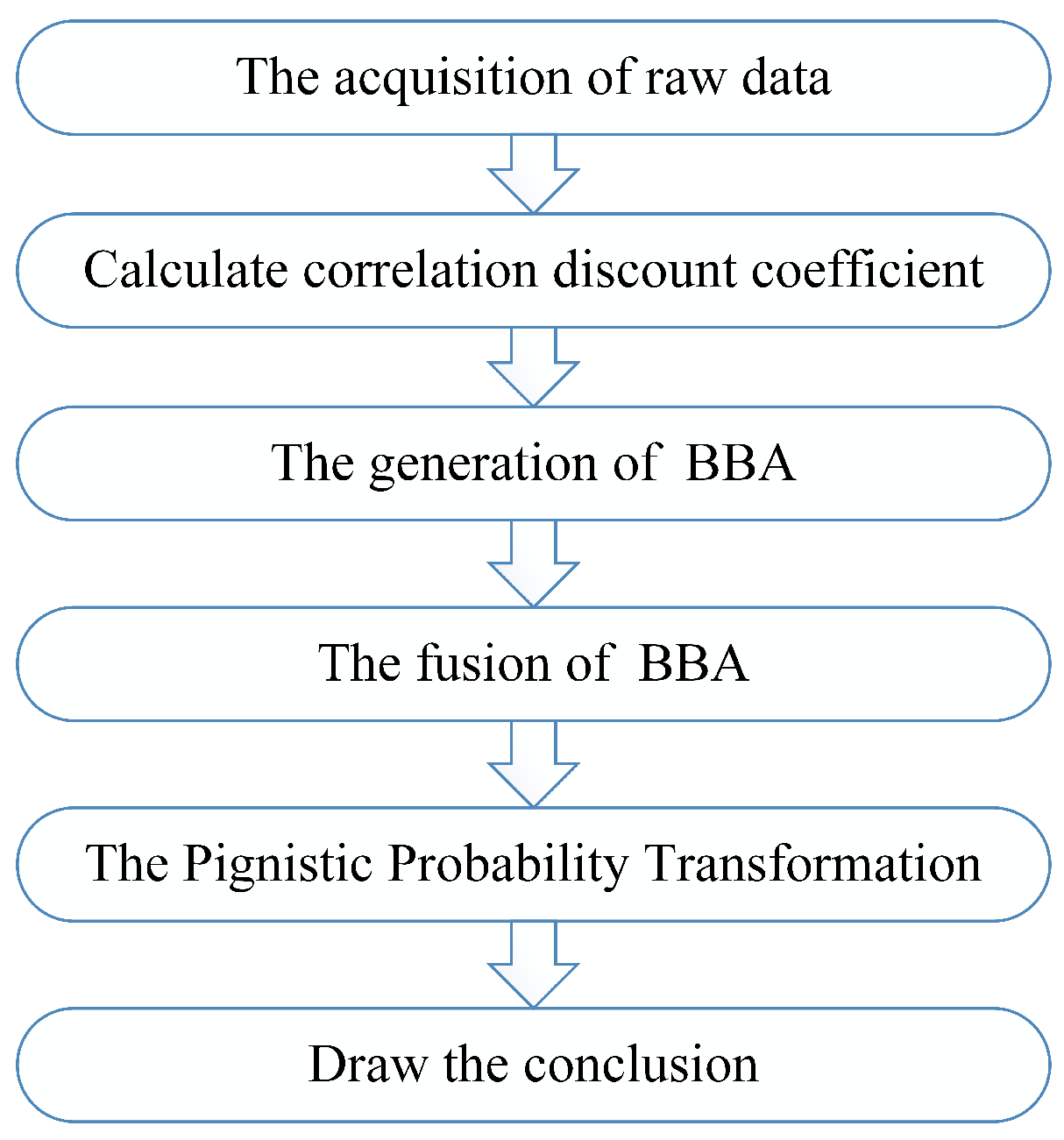
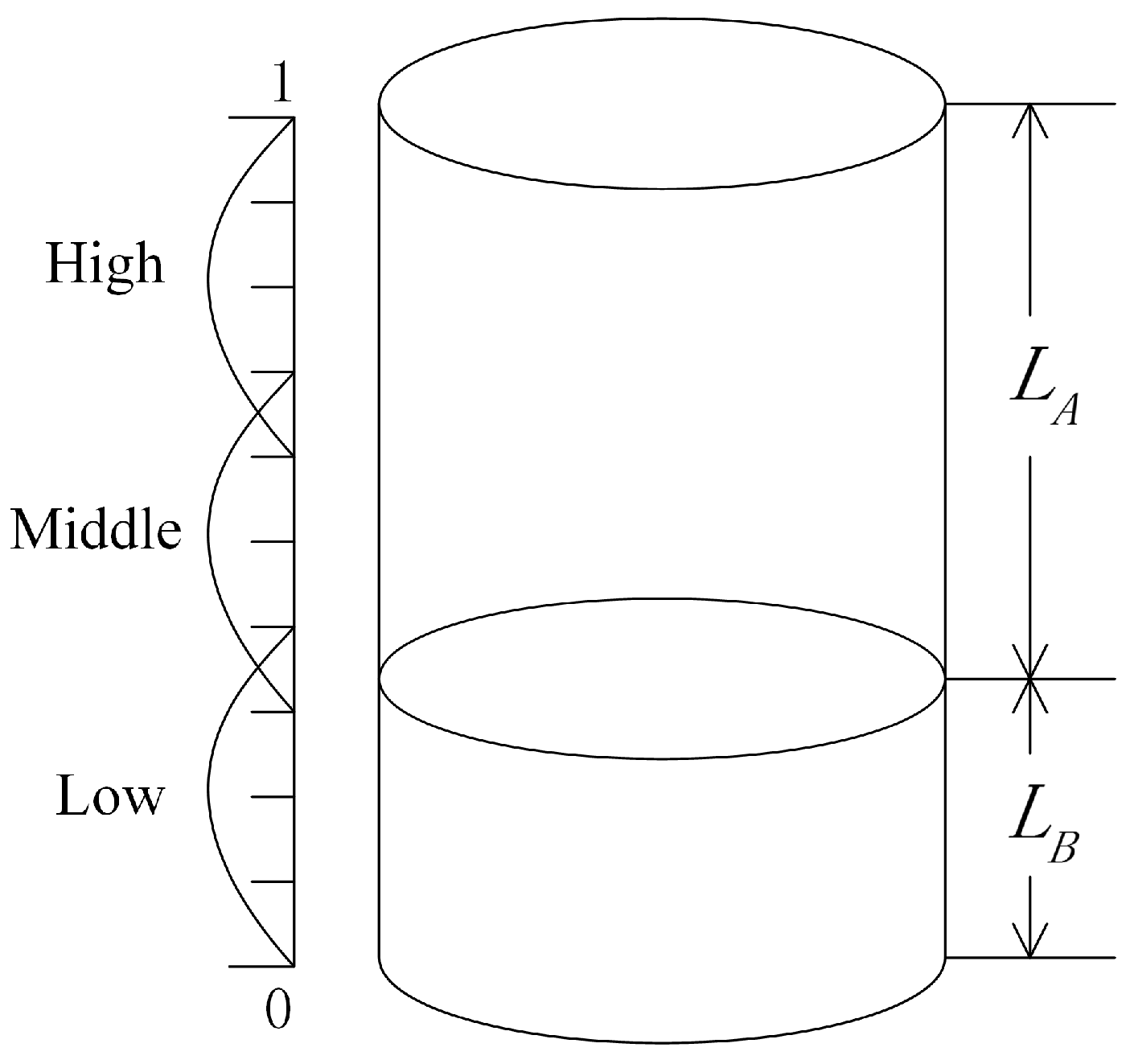
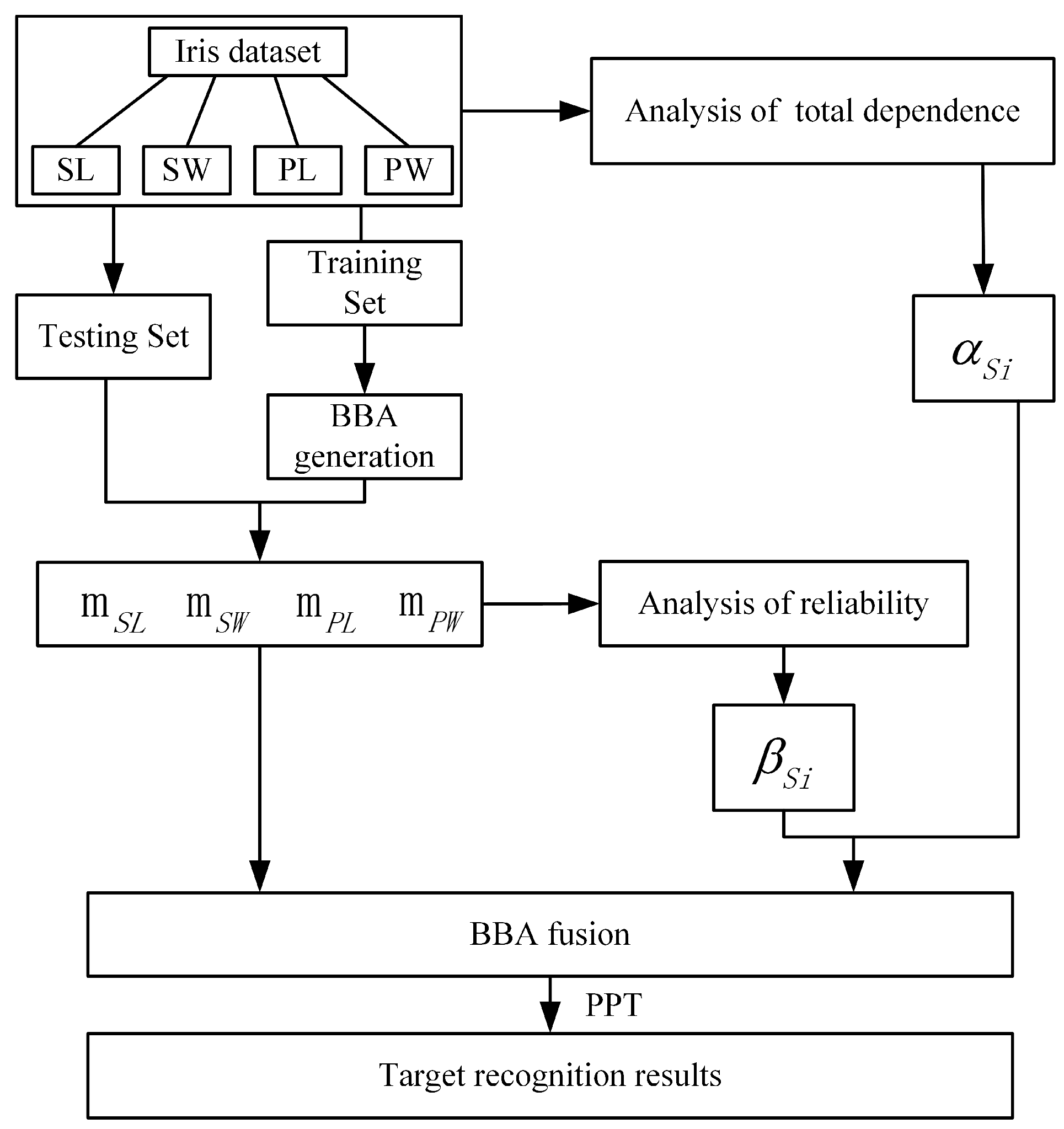
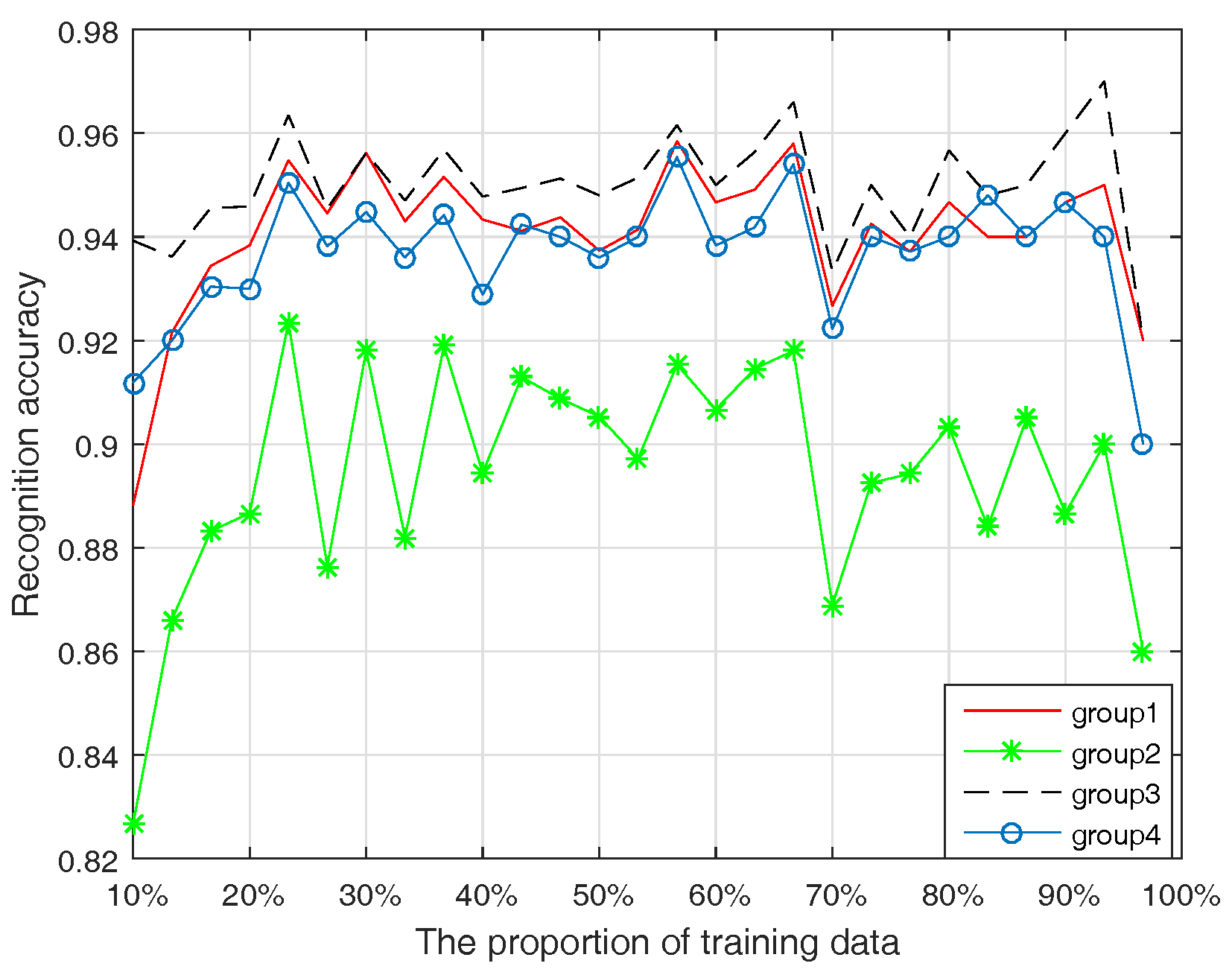
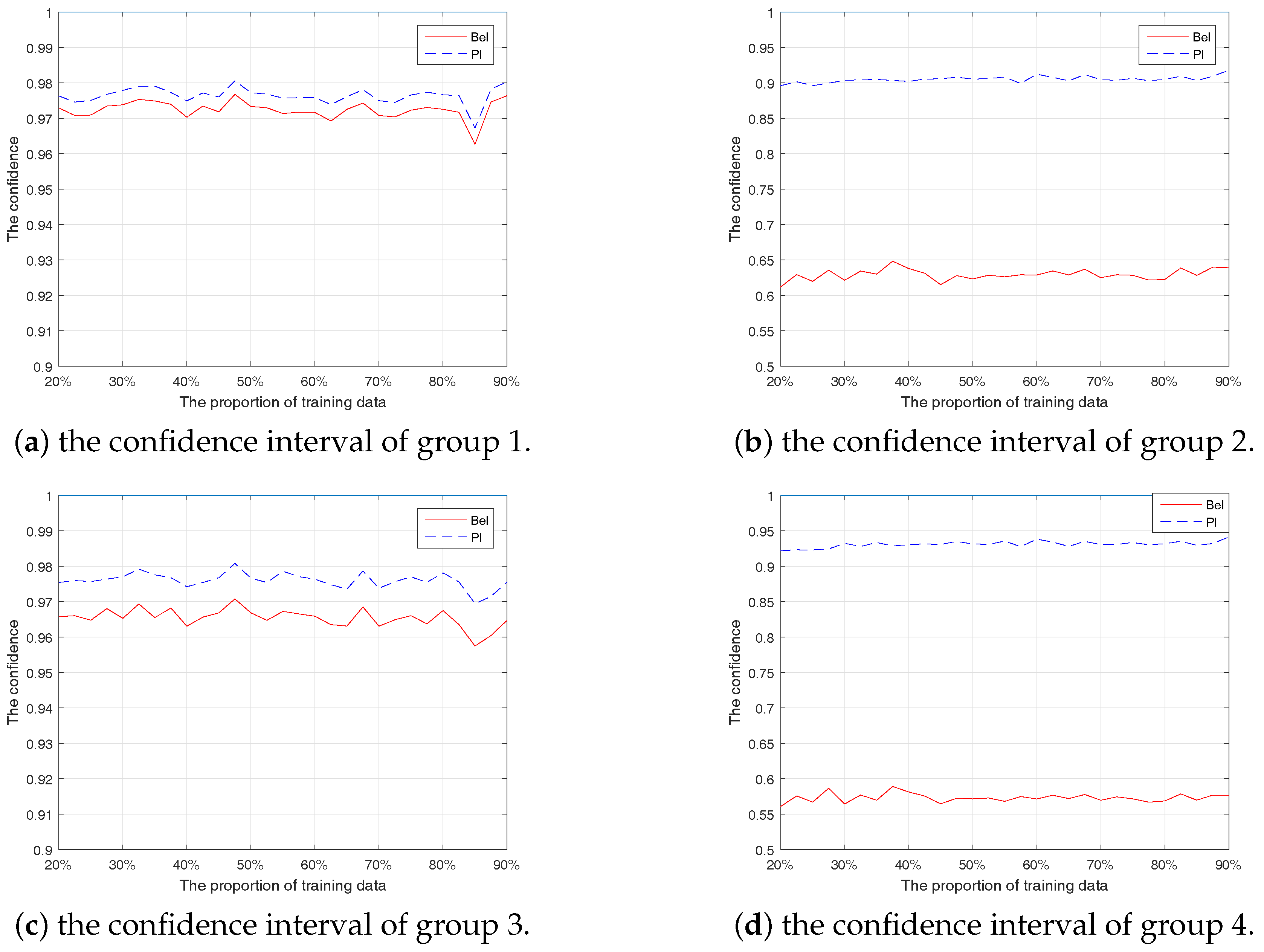
| Attribute | SL | SW | PL | PW |
|---|---|---|---|---|
| SL | 1.0000 | −0.1595 | 0.8814 | 0.8344 |
| SW | −0.1595 | 1.0000 | −0.3034 | −0.2775 |
| PL | 0.8814 | −0.3034 | 1.0000 | 0.9360 |
| PW | 0.8344 | −0.2775 | 0.9360 | 1.0000 |
| Coefficient | SL | SW | PL | PW |
|---|---|---|---|---|
| reliability coefficient | 0.7267 | 0.5467 | 0.9533 | 0.9600 |
| correlation coefficient | 0.3478 | 0.5746 | 0.3204 | 0.3281 |
| Item | BBA | PPT | Recognition Result |
|---|---|---|---|
| R1 | A | ||
| R2 | A | ||
| R3 | A | ||
| R4 | B |
© 2017 by the authors. Licensee MDPI, Basel, Switzerland. This article is an open access article distributed under the terms and conditions of the Creative Commons Attribution (CC BY) license (http://creativecommons.org/licenses/by/4.0/).
Share and Cite
Shi, F.; Su, X.; Qian, H.; Yang, N.; Han, W. Research on the Fusion of Dependent Evidence Based on Rank Correlation Coefficient. Sensors 2017, 17, 2362. https://doi.org/10.3390/s17102362
Shi F, Su X, Qian H, Yang N, Han W. Research on the Fusion of Dependent Evidence Based on Rank Correlation Coefficient. Sensors. 2017; 17(10):2362. https://doi.org/10.3390/s17102362
Chicago/Turabian StyleShi, Fengjian, Xiaoyan Su, Hong Qian, Ning Yang, and Wenhua Han. 2017. "Research on the Fusion of Dependent Evidence Based on Rank Correlation Coefficient" Sensors 17, no. 10: 2362. https://doi.org/10.3390/s17102362
APA StyleShi, F., Su, X., Qian, H., Yang, N., & Han, W. (2017). Research on the Fusion of Dependent Evidence Based on Rank Correlation Coefficient. Sensors, 17(10), 2362. https://doi.org/10.3390/s17102362





